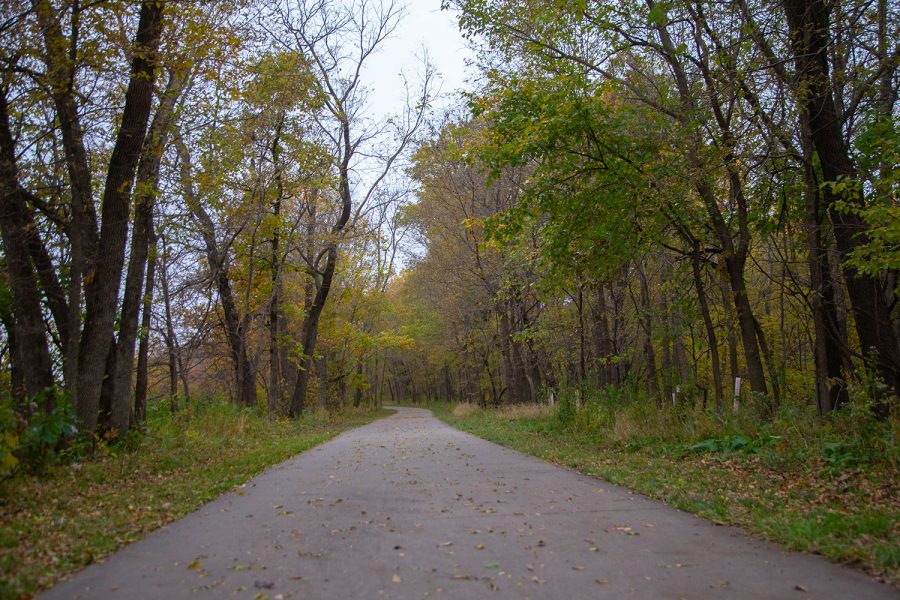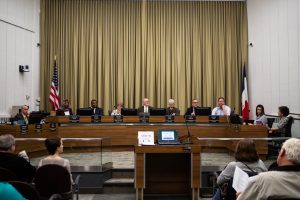Iowa City Parks and Recreation to restore Terry Trueblood Rec Area with grant money
Iowa City Parks and Recreation recently received a $200,000 grant from the Iowa Department of Natural Resources to restore native species in the Terry Trueblood Recreation Area.
Thee Weidman Walk trail at Terry Trueblood Recreation Area is seen on Monday, Oct. 28, 2019.
November 4, 2019
In an effort to help preserve native species to Iowa City’s parks, the Iowa Department of Natural Resources is helping to fund the restoration and cleaning of the Terry Trueblood Recreation Area.
The Department of Natural Resources provided a $200,000 grant to the Iowa City Parks and Recreation Department from its program known as REAP, or Resource Enhancement and Protection, Parks and Recreation Director Juli Seydell Johnson said.
“[REAP] is a fund made possible through the Iowa Legislature each year and it is focused on ecological restoration of Iowa’s public lands,” Seydell Johnson said.
Tammie Krausman, resource enhancement and production coordinator, said the program aims to provide the state of Iowa with resources to maintain natural diversity.
“Iowa is blessed with a diverse array of natural and cultural resources, and REAP is likewise diverse and far reaching,” Krausman said in an email to The Daily Iowan.
State appropriations fund the program. This year, the program received $12 million for its efforts, Krausman said.
RELATED: City plans inaugural 100-mile bike ride at Terry Trueblood Recreation Center
Seydell Johnson added that the majority of the work at Terry Trueblood Recreation Area entails eliminating invasive species. Among the invasive species that will be removed are multiflora rose, honeysuckle, barberry, privet, garlic mustard, and Japanese hops, Seydell Johnson said.
“[These species] have grown up very heavily in those areas and are not meant to be there,” Seydell Johnson said. “[The invasive species] are choking out the good stuff that we want to have growing in the woodlands.”
In addition to removing the invasive species, Seydell Johnson said Iowa City Parks and Recreation will re-establish groundcover in the forested areas and control burning of the prairie areas.
University of Iowa students initially raised awareness of the invasive species at Terry Trueblood Recreation Area, Seydell Johnson said.
A spring 2018 theme semester titled “Climate for Change” focused on exploring aspects of sustainability, UI Professor Richard Fosse said. One aspect of this theme semester urged students to study the Terry Trueblood Recreation Area.
“We rallied some University of Iowa resources that could assemble information and evaluate information that would be useful for the city,” Fosse said.
Key aspects of the work UI students completed as part of this project included surveying the vegetation and water conditions, Fosse said.
“We looked at the ground surface out there and specifically some of the vegetative issues,” Fosse said. “What was found is that there are indeed invasive species out there.”
Krausman recognized the benefits of the work that Iowa City Parks and Recreation plans to accomplish.
RELATED: New Iowa Policy Project climate report calls policymakers to action
“By eliminating invasive plants and installing native species, it will improve the water quality of the lake and support a greater diversity of plants, birds, mammals, amphibians, reptiles, and invertebrates,” Krausman said. “Also, this area is utilized by many residents and visitors for lots of different types of recreational uses.”
Seydell Johnson said the recent growth of invasive species at the Terry Trueblood Recreation Area is a result of climate change.
“The climate is changing, so it has become easier for invasive species to establish in areas that aren’t maintained very well,” Seydell Johnson said.
The Resource Enhancement and Production grant will allow the native species to catch up and allow the Terry Trueblood Recreation Area to live up to its full potential.
“This will open it up and make it a healthy woodland, but also make it a place that is easier to explore,” Seydell Johnson said.





